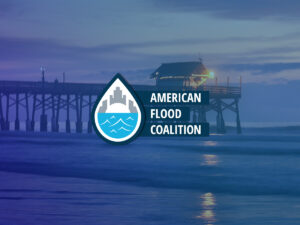
This summer, parts of Vermont and New York saw two months’ worth of rain in two days. Similarly intense rainstorms this year have flooded Southeast Pennsylvania and Fort Lauderdale, as well as vast areas of California.
Though these regions are no strangers to rainstorms and flooding, the magnitude of recent storms should give us pause. Such storms, which dump significantly more rain over shorter time frames compared to past storms, are expected to increase.
Understanding this trend is important, especially with the influx of hundreds of billions of dollars from the bipartisan infrastructure law going toward projects that will serve states and communities for decades. But as engineers, planners, and builders seek funding for new projects or to upgrade existing assets, many are doing so with outdated federal data that does not account for the intensity of future rainfall.
Without accurate, forward-looking rainfall data, communities develop a false sense of security by building infrastructure that isn’t designed to withstand the new reality of stronger storms. Such data leaves communities vulnerable to the next disaster, while also leading to wasteful spending of taxpayer dollars.
At the American Flood Coalition, we’re working to ensure communities are equipped with the data they need to build resilient infrastructure. In this post, we explore recent steps by the federal government to make available accurate, forward-looking rainfall data, as well as the work that still must be done.
Atlas 14: The authoritative, and limited, source for rainfall data
Currently, engineers rely on an authoritative federal source of rainfall data called Atlas 14. Released by the National Oceanic and Atmospheric Administration (NOAA), Atlas 14 provides estimates for rainfall expected at a given location.
But there’s a catch: Atlas 14 is only based on historic rainfall records. So when engineers and planners use it to build infrastructure expected to last decades, they’re doing so without data that accounts for rainstorms we can expect in the future.
Because NOAA only considers historical data, Atlas 14 underestimates the amount of rainfall in many regions — not only in the future but also for data currently on the books. New research by the First Street Foundation further shows that by failing to account for future rainfall trends, the federal government underestimates risk. Notably, the study shows that over half the population live in or near areas that are twice as likely to experience severe rainfall events, as compared to the findings from Atlas 14.
Outdated data across states
Another known problem with Atlas 14 is that its rainfall studies were completed at irregular intervals, with data for different regions arriving at different times. This leaves policymakers with a fractured picture of risk.
If states or municipalities want updated rainfall records, they historically needed to request and then pay for a report from the federal government, or invest in this data through partnerships with academic institutions or other partners. This has led to federal records that, in some cases, haven’t been updated in 50 years.
An NPR report finds that 22 states and the District of Columbia have federal rainfall records that are over 15 years old. And five states’ Atlas 14 records haven’t been updated since at least 1975.
This lack of updated federal data not only leaves large swaths of the country vulnerable to future storms — it also highlights the inequity of the current system. Small, rural, and less wealthy communities often lack resources to fund their own studies, so they use less accurate federal data to inform investments. In other words, they end up putting taxpayer dollars toward projects that can’t withstand stronger storms and heavier rains.
Atlas 15: An updated, forward-looking source of rainfall data
The good news is that NOAA is working on Atlas 15, which will serve as an updated, authoritative source of current— and future — rainfall data for the entire country. But NOAA’s best-in-class science takes time: The agency has committed to releasing final Atlas 15 data for the continental U.S. during 2026, followed by Alaska, Hawaii, and U.S. territories in 2027.
As we’ve seen from extreme rainfall across the country, states and local jurisdictions need accurate precipitation data now, especially as they build infrastructure to withstand current and future storms.
Transformational federal investment is already flowing into transportation, water, energy, and other projects — as of summer 2023, roughly 35,000 projects were awarded funding from the bipartisan infrastructure law. Unfortunately, NOAA’s stated timeline for Atlas 15 will be years too late, with hundreds of billions of dollars already spent on projects built with old data.
Given these stakes, the American Flood Coalition is working to help NOAA close this timing gap. We’ve proposed that NOAA release interim data, with appropriate guidance, within the next 12 to 18 months. Such an approach helps guide infrastructure decisions being made now while NOAA finalizes its Atlas 15 products. This approach is not novel: NOAA and other government entities currently allow access to interim data along these lines.
The FLOODS Act authorizes data updates every 10 years
NOAA’s work to deliver Atlas 15 follows Congress’s enactment of the bipartisan Flood Level Observation, Operations, and Decision Support (FLOODS) Act. Passed in December 2022, the FLOODS Act will ensure communities can access timely updates to rainfall data, starting with Atlas 15, and for decades into the future.
Rather than only update rainfall data when states request it, the FLOODS Act for the first time authorizes funding for NOAA to update nationwide rainfall data every 10 years. The law also supports NOAA’s critical work to monitor, forecast, and communicate about floods and hurricanes, and it will further the agency’s use of forward-looking, timely data to inform state and local planning, as well as provide communities with localized technical support for NOAA products and services.
The FLOODS Act will also improve flood watches and warnings and establish a committee to promote coordination among federal entities with joint or overlapping water management responsibilities. The American Flood Coalition applauds the passage of this law, as it will help leaders make informed investments in flood-resilient infrastructure in the face of stronger storms and more frequent flooding.
What communities can do right now
While Atlas 15 remains in progress, states and communities should determine if their jurisdictions have invested in any non-federal precipitation data, such as what has been done in New Jersey, Washington, and elsewhere.
To better understand risk to make decisions, states and communities can also use the State Resilience Partnership’s Flood Risk Data Collection & Assessment Framework. Accurate rainfall data is a necessary and early component for flood mapping and risk assessments. With such data, communities can make smart, informed decisions about how to design and build infrastructure to ensure public safety.
Using the right data going forward
Thanks to historic funding from the bipartisan infrastructure law, states and communities have an incredible opportunity to build for a future of higher seas and stronger storms; however, they must do so while using the right data.
Between new federal updates and legislation, alongside resources like the Flood Risk Data Collection & Assessment Framework, communities will soon have the data necessary to build and upgrade infrastructure that can withstand today’s storms, as well as tomorrow’s floods.




